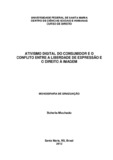| dc.contributor.advisor | Oliveira, Rafael Santos de | |
| dc.creator | Machado, Scheila | |
| dc.date.accessioned | 2017-05-04T02:05:57Z | |
| dc.date.available | 2017-05-04T02:05:57Z | |
| dc.date.issued | 2012-12-13 | |
| dc.date.submitted | 2012 | |
| dc.identifier.uri | http://repositorio.ufsm.br/handle/1/2812 | |
| dc.description | Trabalho de conclusão de curso (graduação) - Universidade Federal de Santa Maria, Centro de Ciências Sociais e Humanas, Curso de Direito, RS, 2012. | por |
| dc.description.abstract | Consumers affected by vices in the ratio of consumption have used the Internet to voice their dissatisfaction. The placement of complaints on the web can generate damaging the company claimed. This situation brings into conflict the freedom of expression and right to the consumer's perception of the supplier. This study aims to analyze such a collision of fundamental rights. To do so, check the connection between the Internet, digital activism and cyberconsumer. It also examines the case law on exemplary cases. Studies, in addition, the concepts and boundaries of constitutional principles in conflict. Investigates also the configuration of abuse of law in excessive exercise of the right to freedom of expression. Therefore, we adopt the method of deductive approach, treating the assumptions Internet, cyber activism, and consumer cybercitizenship 2.0 and having a complete analysis of the clash between freedom of expression and right to the image. Is adopted, too, the method of historical procedure to outline the emergence and evolution of the elements relevant to the topic. The monographic method of procedure is employed to conceptualize and define the scope of legal institutions involved. This work is divided into two chapters, each subdivided into three topics. From the analysis of the proposed clash concluded that the confrontation resolves itself by applying the principle of proportionality. Can remain configured abuse of law if excessive exercising freedom of expression. In that case, apply to the duty to indemnify and the duty to respond, individually or together. It is the examination of the subject is still very recent and superficial. The judgments were handed down concerning the topic at headquarters injunction, there is even opposing understandings. The question requires careful analysis and detailed the peculiarities involved with regard to the Internet, their characteristics and principles that guide as well as the particularities of the case. | eng |
| dc.language | por | por |
| dc.publisher | Universidade Federal de Santa Maria | por |
| dc.rights | Acesso Aberto | por |
| dc.subject | Ativismo digital | por |
| dc.subject | Consumidor 2.0 | por |
| dc.subject | Reclamações online | por |
| dc.subject | Liberdade de expressão | por |
| dc.subject | Direito à imagem | por |
| dc.subject | Abuso de direito | por |
| dc.subject | Digital activism | eng |
| dc.subject | Consumer 2.0. | eng |
| dc.subject | Complaints online | eng |
| dc.subject | Freedom of expression | eng |
| dc.subject | Image rights | eng |
| dc.subject | Abuse of rights | eng |
| dc.title | Ativismo digital do consumidor e o conflito entre a liberdade de expressão e o direito à imagem | por |
| dc.title.alternative | Digital consumer activism and the conflict between freedom of expression and the right to file | eng |
| dc.type | Trabalho de Conclusão de Curso de Graduação | por |
| dc.degree.local | Santa Maria, RS, Brasil | por |
| dc.degree.graduation | Curso de Direito | por |
| dc.description.resumo | Os consumidores atingidos por vícios na relação de consumo têm usado a Internet para manifestarem suas insatisfações. A veiculação das queixas na web pode gerar danos à empresa reclamada. Essa situação põe em conflito a liberdade de expressão do consumidor e o direito à imagem do fornecedor. Este trabalho visa analisar tal colisão de direitos fundamentais. Para tanto, verifica o vínculo existente entre a Internet, o ativismo digital e o ciberconsumidor. Além disso, examina a jurisprudência relativa a casos exemplificativos. Estuda, ademais, os conceitos e delimitações dos princípios constitucionais em conflito. Apura, ainda, a configuração de abuso de direito no exercício excessivo do direito à liberdade de expressão. Para tanto, adota-se o método de abordagem dedutivo, tratando das premissas Internet, ciberativismo, cibercidadania e consumidor 2.0 e tendo por conclusão a análise do embate entre liberdade de expressão e direito à imagem. Adota-se, também, o método de procedimento histórico a fim de delinear o surgimento e evolução dos elementos pertinentes ao tema. O método de procedimento monográfico é empregado para conceituar e delimitar o alcance dos institutos jurídicos envolvidos. Este trabalho divide-se em dois capítulos, cada um subdividido em três tópicos. Da análise do embate proposto conclui-se que o confronto soluciona-se pela aplicação do princípio da proporcionalidade. Pode restar configurado o abuso de direito se excessivo o exercício da liberdade de expressão. Nessa hipótese, aplicam-se o dever de indenizar e o direito de resposta, isolada ou conjuntamente. Tem-se que o exame do tema ainda é muito recente e superficial. As decisões judiciais referentes à temática foram prolatadas em sede liminar, havendo inclusive entendimentos contrapostos. A questão exige análise minuciosa e aprofundada das peculiaridades envolvidas no que se refere à Internet, suas características e os princípios que a norteiam, bem como às particularidades do caso concreto. | por |
| dc.publisher.unidade | Centro de Ciências Sociais e Humanas | por |


